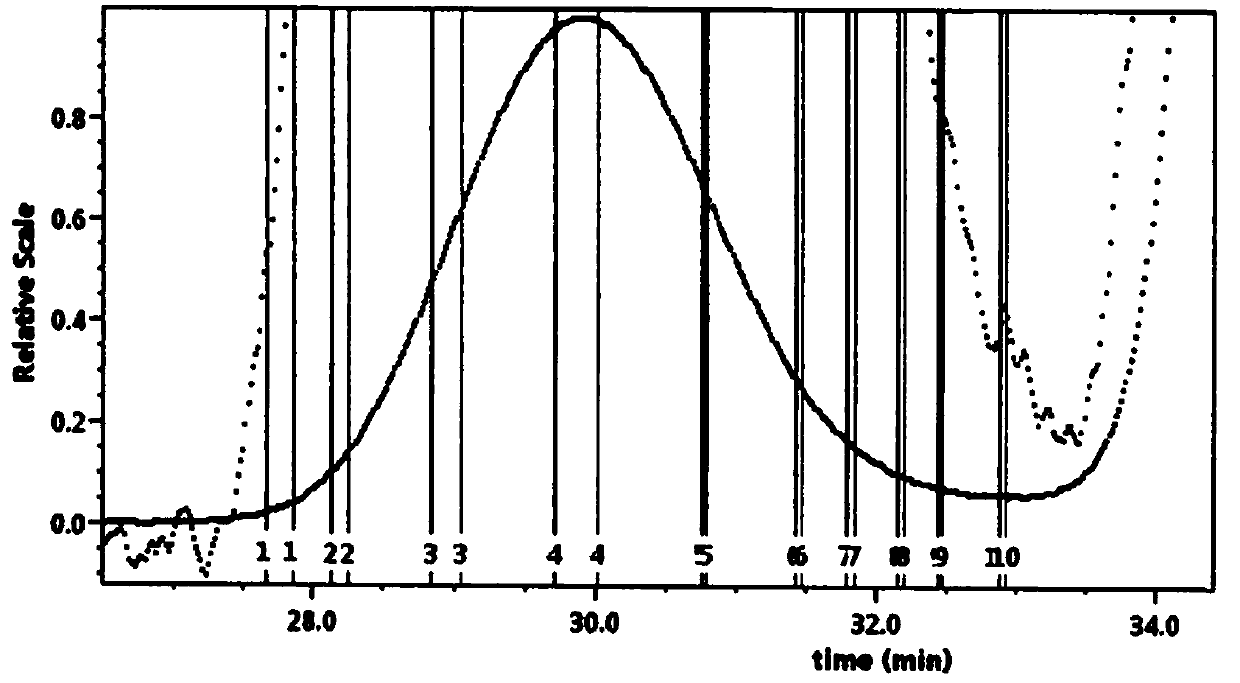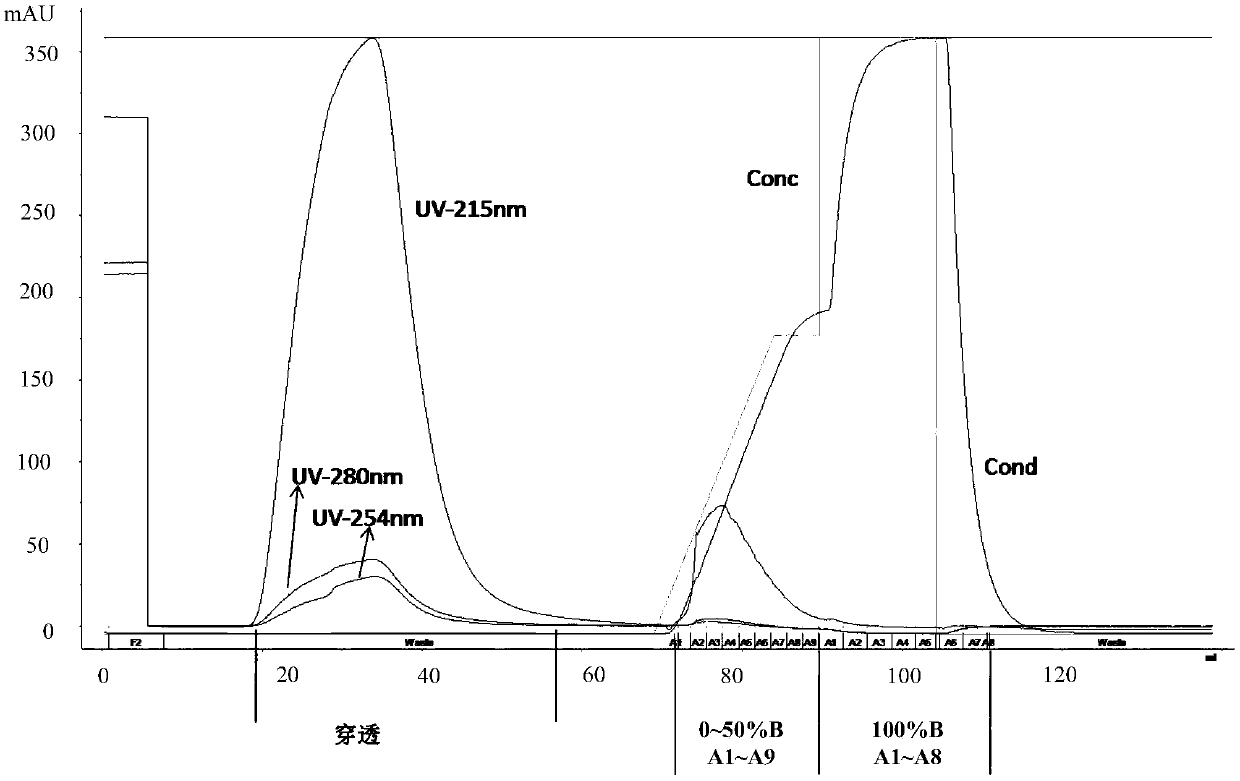Conjugate of polyethylene glycol-polypeptide and protein drug
A polyethylene glycol and conjugate technology, applied in the field of medicine, can solve the problems of reducing drug immunogenicity and toxicity, adverse patient compliance, poor targeting, etc.
- Summary
- Abstract
- Description
- Claims
- Application Information
AI Technical Summary
Problems solved by technology
Method used
Image
Examples
Embodiment 1
[0259] Example 1: Synthesis of Linker Chain (L)
[0260]
[0261] Add BOC-amino acid (92.2mmol) and N,N-dicyclohexylcarbodiimide (DCC, 23.8g, 115.3mmol) into dichloromethane (500mL), cool in an ice-water bath, then add p-hydroxybenzyl alcohol ( 11.4 g, 92.2 mmol), the ice bath was removed after the addition, and the reaction was carried out overnight at room temperature. After filtration, the filter cake was washed with ethyl acetate, and the filtrate was evaporated to dryness to obtain a crude product, which was purified by column chromatography to obtain product 1.
[0262] 1a: 19.7g, yield 76.0%. 1 H NMR: (CDCl 3 ): 8.75(s,1H), 7.22(d,2H), 7.05(d,2H), 4.87(s,2H), 3.74(s,2H), 1.52(s,9H).
[0263] 1b: 20.3g, yield 74.8%. 1 H NMR: (CDCl 3 ):8.74(s,1H),7.21(d,2H),7.05(d,2H),4.88(s,2H),3.77(m,1H),1.51(s,9H),1.27(d,3H) .
[0264] 1c: 21.6g, yield 72.5%. 1 H NMR: (CDCl 3 ):8.75(s,1H),7.22(d,2H),7.05(d,2H),4.87(s,2H),3.61(d,1H),2,82(m,1H),1.52(s, 9H), 1.06(d, 6H).
[...
Embodiment 2
[0269] Embodiment 2: the synthesis of the conjugate (mPEG-L-40K) of monomethoxypolyethylene glycol acetic acid and connecting chain
[0270]
[0271] Monomethoxypolyethylene glycol-acetic acid (mPEG-CM, 40K, 5g, 0.125mmol), compound L (0.25mmol, prepared in Example 1) and 1-hydroxybenzotriazole (HOBt, 16.9mg, 0.125mmol) into the reaction flask, dissolved in dichloromethane, then added diisopropylethylamine (45.2mg, 0.35mmol), stirred evenly, and added in batches after cooling in an ice bath (EDCI, 47.9mg, 0.25mmol ), after the addition, the system naturally rose to room temperature and reacted overnight. After concentrating the next day, the residue was crystallized with isopropanol, filtered with suction, and dried to obtain the product mPEG-L.
[0272] mPEG-L1 (40K): 4.6 g, yield 92.4%.
[0273] mPEG-L2 (40K): 4.5g, yield 90.8%.
[0274] mPEG-L3 (40K): 4.7g, yield 93.7%.
Embodiment 3
[0275] Example 3: Preparation of linking chain L5
[0276] The synthetic route of linker chain L5 is as follows:
[0277]
[0278] Synthesis of compound (2):
[0279] 3,4-Dihydroxybenzaldehyde (10g, 72.5mmol) was dissolved in acetonitrile (150mL), sodium bicarbonate (8g, 94.3mmol) was added, the temperature was raised to 60°C, benzyl bromide (12.4g, 72.5mmol) was added, and Raise the temperature to 80°C and stir overnight. Concentrate to remove acetonitrile, add 10% hydrochloric acid aqueous solution (200mL) to the residue, extract with ethyl acetate (150mL*3), combine and dry, filter, concentrate, and the residue is purified by column chromatography to obtain off-white solid 10g (yield 60 %). 1 H NMR: (CDCl 3 ): δ9.82 (s, 1H), 7.48-7.40 (m, 7H), 7.05 (m, 1H), 6.02 (s, 1H), 5.21 (s, 2H).
[0280] Synthesis of compound (3):
[0281] Compound (2) (5g, 21.9mmol) was dissolved in DMF (80mL), potassium carbonate (7.6g, 54.75mmol), potassium iodide (0.73g, 4.38mmol) were ad...
PUM
| Property | Measurement | Unit |
|---|---|---|
| Molecular weight | aaaaa | aaaaa |
Abstract
Description
Claims
Application Information
 Login to View More
Login to View More - R&D
- Intellectual Property
- Life Sciences
- Materials
- Tech Scout
- Unparalleled Data Quality
- Higher Quality Content
- 60% Fewer Hallucinations
Browse by: Latest US Patents, China's latest patents, Technical Efficacy Thesaurus, Application Domain, Technology Topic, Popular Technical Reports.
© 2025 PatSnap. All rights reserved.Legal|Privacy policy|Modern Slavery Act Transparency Statement|Sitemap|About US| Contact US: help@patsnap.com



